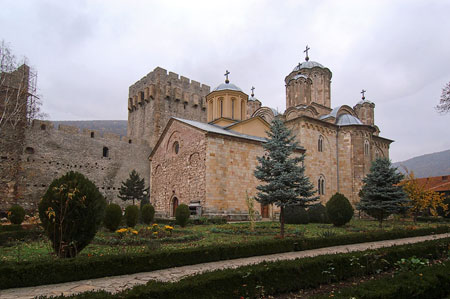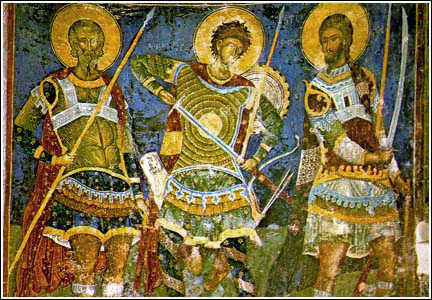Monastery Manasija - Манастир МАНАСИЈА
Monastery Manasija
The Manasija monastery was founded by Despot Stefan Lazarevic; the church, dedicated to the Holy Trinity, was erected and painted between 1407 and 1418. The monastery is surrounded by massive walls and towers.
Since the end of the XVIIth century Manasija monastery has been assembling educated monks who have fostered literary and copying work, called the Resava School. Already in 1456 Manasija was burnt by the Turks; after 1718, when Austrians took the monastery (and all of northern Serbia), they kept the gunpowder in the narthex, which exploded and blew the ante-church up. A new narthex was built in 1735. At the beginnings of the Serbian revolution, in 1804, the monastery was abandoned and in ruins again. The monastery was partly renewed, between 1807. and 1810, and the restoration works completed in 1845.
Architecturally, the church belongs to the Morava School. The ground plan is in the form of a floral inscribed cross, combined with a trefoil. The twelwe-side dome above the central space rests on four free standing pillars. At the eastern end there are one large and two small apses, whereas two large choir conches flank the altar. Above the corners of the church there are four little octagonal domes. The narthex consists of nine bays. Above the central bay there is yet another dome that rests on four pillars. The church was built on ashlars and thin mortar beds. The facade decoration includes low pilasters, engaged colonettes on the conches and apses, as well as a frieze of small blind arcades on brackets running below the roof cornice. The ornaments have suffered serious damages.
In the inside, the original floor has been preserved in the narthex, made of marble tiles in various colors. Nearly half of the frescoes have been destroyed. Despot Stefan is portrayed with the church model on the left-hand wall. The lower register of the north choir depicts warrior-saints in armor with swords and lances, as an authentic representation of contemporaneous soldiers. The vault above the main door contains a picture of the Souls of the Righteous held by the Divine hand. On the left and right, the prophets David and Solomon are portrayed respectively. There are also 24 portraits of the Old Testament prophets and patriarchs in the spacious dome. Two compositions cover the whole first and second registers in the altar: the first represents the Adoration of the Lamb, the other the Communion of Apostles.
The Monastery fortress, made up to defend the monastery, especially from the Turks, consists of 11 towers linked with huge walls and once, with trenches. The towers are mostly rectangular, save two hexagonal ones and one square-shaped.
Манастир МАНАСИЈА
Манасија (Ресава) је један од најзначајнијих споменика српске средњовековне културе и припада такозваној „Моравској школи“. Подигао је деспот Стефан Лазаревић - Високи између 1407. и 1418. године. Одмах после оснивања, Манасија је постала културни центар деспотовине. Њена „Ресавска школа“ била је по својим преводима и преписима чувена - и после пада деспотовине - кроз цео XV и XVI век.
У току вишевековне турске окупације, манастир је више пута пустошен и разаран. Са цркве је био скинут оловни кров, па је више од једног века црквена грађевина прокишњавала и 2/3 фресака је неповратно пропало.
Западни део цркве, такозвана „припрата“ приликом једне експлозије у XVIII веку тешко је оштећена, па је данашња припрата већим делом накнадно дозидана. Срећом, у том делу цркве очуван је под у мозаику, који је рађен од крупног разнобојног камена.
Иако тешко оштећен, животопис Манасије спада у ред највећих домета средњовековног сликарства. Од очуваних фресака прво заслужује пажњу криторска композиција на западном зиду главног дела цркве, на којој је сачуван портрет деспота Стефана. На јужном и северном зиду - у певницама - очувани су величанствени ликови светих ратника. У горњим зонама певница насликане су сцене из живота Господа Христа и илустроване Његове приче из Јеванђеља. У главном кубету су представљени старозаветни пророци. У олтару је насликано Причешће апостола и Поворка светих отаца, међу којима је (последњи у реду према северу) први српски архиепископ - Свети Сава. На стубовима су добро очувани медаљони са попрсјима светитеља, као лик светог арханђела Михаила (на јужном) и светог Петра Александријског (на северном стубу).
Манасија је пустошена и разарана 1439, 1456, 1476, и 1734, а обнављана 1735, 1806, 1810, и 1845. године. Завод за заштиту споменика културе (тада) СР Србије отпочео је 1956. године обимне конзерваторско-рестаураторске радове. Чишћења и конзервација фресака извршени су од 1959. до 1962. године.








